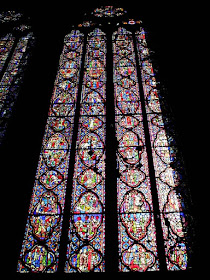On the heights of Amboise there is a spur of land with the remains of what was a Celtic then Gallo-Roman settlement on it. It is known as the Oppidum des Chatelliers and the settlement was at its height at the time of Caesar's conquest. The Bronze Age culture who lived here and other places in the Paris Basin are known as the Chassey people.
The cut through the bank.
The most striking of the archaeological remains is the linear rampart, now cut through so you can clearly see it in section. It originally stretched 450 metres and was around 35 metres wide. Its height was once much greater than today. Its reduction was brought about once the plateau began being ploughed and cultivated. In front of the earth bank you can see a flat bottomed ditch.
Solitary bees have been taking advantage of the nice south facing
exposed earth to make their nest holes.
The earth bank, reinforced with wooden stakes, and surrounded by the ditch, would have been the main defensive element for a settlement called an oppidum in Gallo-Roman times. The very visible strata on the cross section shows that it was added to or had maintenance a number of times over its useful life. On the other side the settlement was protected by the natural cliffs which dominate the valleys of the Loire and Amasse Rivers.
The latest archaeological dig on the site, tucked up for the winter.
The Oppidum des Chatelliers was one of the most important cultural and economic centres of the region. It is also a very typical example of hill forts in the area, where a settlement on a spur above the river is fortified behind a barrier sectioning off the end of the natural ridge.
The defensive ditch.
Archaeological research has shown that the site had a population similar to a modern small village and the bank and ditch were begun around 400 BC and finished around 50 BC. Two statues of human form, including an exceptional female idol, have been found on the site. Other finds include pots and Gallic coins.
In the middle of the site the tumulus known as la Butte de César.
The strata of the earth bank, presumably laid down as the Chassey people
dug the ditch and formed the bank.
The view from la Butte de César.
We visited the site in mid-January with friends Antoinette, Rosemary and Jean Michel. Rosemary's post about the earth bank is
here.
***********************************
Loire Valley Nature: A photo has been added to the entry for
Large Skipper butterfly
Ochlodes venatus.


























































